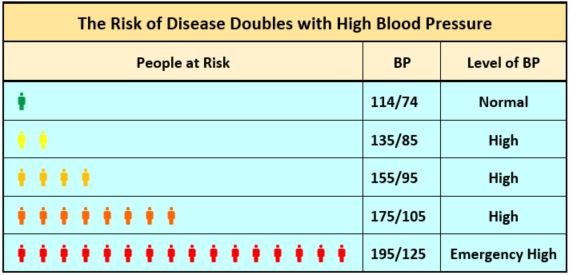According to 2017 hypertension guidelines from the American College of Cardiology and American Heart Association (ACC/AHA), Stage 2 high blood pressure is defined as 140 mm Hg or higher systolic or 90 mm Hg or higher diastolic.1 The risk for heart attack, stroke and other high blood pressure complications begins to increase around 115/75 mm Hg.1-3 For people between ages 40 to 69 years, the risk doubles for each 20 mm Hg increase in the systolic pressure and each 10 mm Hg increase in the diastolic pressure.1,2
Diagnosis of hypertension is based on an average of two or more careful blood pressure readings on two or more occasions when the patient is relaxed, sitting for more than five minutes, and has not done anything recently to increase blood pressure such as smoke or exercise.1
Doctors should promote nonpharmacological therapy to people with Stage 2 high blood pressure.1 Nonpharmacological therapy includes healthy diet, weight loss, sodium reduction, exercise, enhanced intake of dietary potassium, smoking cessation, and moderating alcohol consumption. Use of blood pressure-lowering medications is recommended for people with Stage 2 hypertension. People started on medication should be reassessed in one month.
The 2017 ACC/AHA hypertension guidelines1 also recommend the same treatment protocol for older hypertensive adults (age ≥65 years) who are ambulatory, noninstitutionalized, and community-dwelling. Studies have shown the lower treatment target can still benefit older adults with reduced CVD events and all-cause mortality.2,4 However, they suggest that before initiating any treatment, the risks and benefits be analyzed by the physician, patient, and caregivers for older hypertensive adults who have a limited life expectancy and a high burden of comorbidity as the lower treatment target is less beneficial for older adults who meet these criteria.1,2,5 These recommendations are supported by the 2017 clinical practice guideline6 from the American College of Physicians and the American Academy of Family Physicians on pharmacologic treatment of adults aged 60 years or older.
Evidence shows that lowering blood pressure decreases the risk of adverse cardiovascular outcomes such as heart disease, stroke, and death.6-9 It may also slow the progression of kidney damage in people with chronic kidney disease.10 Further, meta-analyses as well as national and international guidelines suggest that lowering blood pressure decreases risk of these outcomes regardless of which agent is used.6-10
References
- Whelton PK, Carey RM, Aronow WS, et al. 2017 ACC/AHA/AAPA/ABC/ACPM/AGS/APhA/ASH/ASPC/NMA/PCNA guideline for the prevention, detection, evaluation, and management of high blood pressure in adults: executive summary: a report of the American College of Cardiology/American Heart Association Task Force on Clinical Practice Guidelines. Hypertension 2017.
- Lewington S, Clarke R, Qizilbash N, Peto R, Collins R. Age-specific relevance of usual blood pressure to vascular mortality: a meta-analysis of individual data for one million adults in 61 prospective studies. Lancet 2002; 360 (9349): 1903-1913.
- Rapsomaniki E, Timmis A, George J, et al. Blood pressure and incidence of twelve cardiovascular diseases: lifetime risks, healthy life-years lost, and age-specific associations in 1.25 million people. Lancet 2014; 383 (9932): 1899-1911.
- Williamson JD, Supiano MA, Applegate WB, et al. Intensive vs Standard Blood Pressure Control and Cardiovascular Disease Outcomes in Adults Aged >/=75 Years: A Randomized Clinical Trial. JAMA 2016; 315 (24): 2673-2682.
- Wright JT, Jr., Williamson JD, Whelton PK, et al. A randomized trial of intensive versus standard blood-pressure control. N Engl J Med 2015; 373 (22): 2103-2116.
- Qaseem A, Wilt TJ, Rich R, Humphrey LL, Frost J, Forciea MA. Pharmacologic treatment of hypertension in adults aged 60 years or older to higher versus lower blood pressure targets: a clinical practice guideline from the American College of Physicians and the American Academy of Family Physicians. Ann Intern Med 2017; 166 (6): 430-430.
- Ahluwalia M, Bangalore S. Management of hypertension in 2017: targets and therapies. Curr Opin Cardiol 2017; 32 (4): 413-421.
- James PA, Oparil S, Carter BL, et al. 2014 evidence-based guideline for the management of high blood pressure in adults. JAMA 2014; 311 (5): 507-520.
- Pignone M, Viera AJ. Blood pressure treatment targets in adults aged 60 years or older. Ann Intern Med 2017; 166 (6): 445-445.
- KDIGO 2012 clinical practice guideline for the evaluation and management of chronic kidney disease. Kidney Int Suppl (2011) 2013; 3 (1): i-150.


.png)
